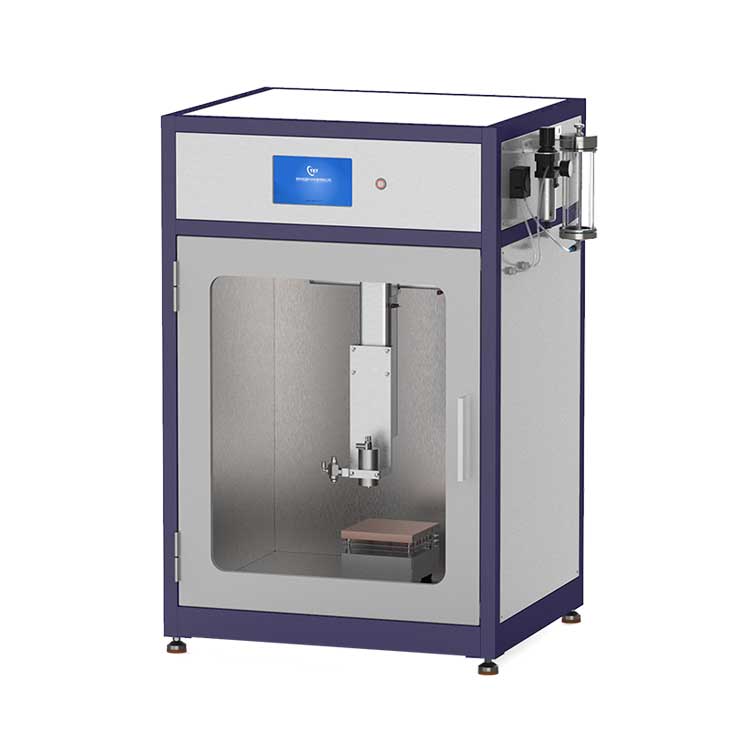Ultrasonic spraying pyrolysis (USP) is a common thin film material preparation process, which is widely used in scientific research and production. This method is good at the preparation of oxide, sulfide, chloride and other compound thin films. Under reasonable process parameters, the quality of USP film can be comparable to that of thin film materials prepared by sputtering and CVD methods, but the cost is greatly reduced.
Ultrasonic atomization pyrolysis spraying to manufacture thin films:
Doped films and multilayer films are very common in the research and production of thin film materials. The traditional USP method has certain problems in doping and multilayer film preparation. The main problem is that there is only one atomization in the pyrolytic spraying reaction chamber. The atomization source sprays droplets of different composition into the reaction chamber according to the composition of the film during operation. At the same time, some reaction chambers currently have multiple atomization sources, but these atomization sources share the same atomization tube, and the axis of the atomization tube is parallel to the axis of the sample matrix. When manufacturing multi-layer composite films or doped deposition films, it is necessary to spray droplets of different compositions, and chemical reactions may occur between droplets of different compositions. Therefore, the use of the above two structures is very easy to contaminate the droplets, or let a chemical reaction occurs between the droplets, so that the desired film cannot be obtained. In addition, since the axis of the spray tube is parallel to the axis of the sample matrix, the droplets are incident perpendicularly, which makes it easy to recoil the droplets downward, which is not conducive to the deposition and formation of thin films.
Thermal decomposition and film precipitation to form a film:
The existing pyrolysis spraying reaction chamber is equipped with a rotating sample carrier, the sample carrier is used to fix the sample substrate, the carrier is coaxially connected with the lower end of the output shaft of the motor through a rotating rod, and the motor is fixed on the bracket through the bracket. The upper surface of the upper cover, and the upper cover is sealed with the top surface of the reaction chamber, and the upper cover can be opened when the sprayed product is replaced. An iodine tungsten lamp is arranged above the carrier, so that a high-temperature thermal reaction zone is formed in the area near the carrier through the tungsten iodine lamp, and an atomizer is arranged under the sample carrier. When working, the atomizer sprays atomized droplets from bottom to top, and shoots them to the high-temperature area near the sample carrier and the sample substrate, and forms a thin film on the sample substrate through thermal decomposition and film precipitation. The bottom-up spray structure realizes the function of droplet size selection to a certain extent, and relies on gravity to realize the function of particle size selector, because the larger droplets cannot reach the high temperature area and the surface of the sample substrate under the action of gravity. This improves the quality of film deposition, which is beneficial for improving the surface finish of film materials, reducing and eliminating film growth stress, and reducing or eliminating structural defects.

During use, we found that the high-temperature reaction tail gas would gather near the sample carrier, and then form a high-temperature reaction tail gas layer. This high-temperature reaction tail gas layer would prevent the droplets ejected from the atomizer from being directed to the sample substrate and reduce the fog. The momentum of the drop incident on the surface of the sample substrate, and it is easy for the droplet to be hindered and then recoil downward, which is also not conducive to the deposition and formation of the film; at the same time, due to the presence of a high-temperature reaction tail gas layer, the high-temperature reaction tail gas layer may contaminate the droplets Or high-temperature reaction exhaust gas enters the deposited film material, which causes the composition of the film to change, so that the film with the desired composition cannot be obtained, and the film crystallinity and density decrease, and structural defects increase.
In addition, the existing structure does not have a heat shielding function, and a large amount of heat energy will be conducted to the top of the reaction chamber, which will cause energy waste. At the same time, the atomized droplets will also fill the inner cavity at the top of the reaction chamber, and the droplets are strong acid or strong alkaline droplets, which are highly corrosive, which will corrode the non-reactive area. In the non-reactive area, there are signal transmission lines and power transmission lines for various test devices, such as thermocouples, heating iodine tungsten lamps, and so on. The presence of corrosion will cause the above devices to reduce the measurement accuracy of the above devices. Although it can be solved by frequent replacement, disassembly and scrubbing are time-consuming and laborious, and the cost of equipment usage will also increase significantly.





